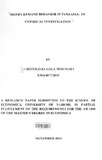| dc.description.abstract | The breakdown in the Money demand models in the mid 1970's popularly known as
the "missing money" episodes, has led many researchers to continue investigating the demand
for money function. In search for a model which can best fit the real situation in various
economies, researchers have continued to re-examine the model through re-specification and
investigating the data used in the model formulation. It is in this light that this paper set out
to examine the role of credit restraint as a better proxy for interest rate variable in the
demand for money function for Kenya where the financial market is undeveloped. The role
of "open economy" variables such as exchange rate and foreign interest rate is also looked
at. The paper also examines the nature of time series data used in estimation of money
demand model by testing for stationarity and if non-stationary, checks for co-integration.
The paper finds that time series data used in the money demand function are non stationary. The finding that the data were non-stationary led us to check whether they are co-integrated,
a test we failed to achieve.To run a non spurious regression, the data used are
in first difference form since this makes them stationary. The ECM could not be incorporated
in our model since the residuals of the non-stationary variables were not co-integrated.
The findings of this paper are that variables capturing the external developments like
exchange rates and foreign interests should explicitly be expressed in the money demand
models. The major findings and conclusions of this paper is that ill economies where the
financial markets are still undeveloped, the degree of credit restraint is a better proxy for
interest rates than any observable rates e.g. the treasury bills discount rate. Through
encompassing tests and other various diagnostic tests, our model proves to be an improved
money demand which fits the Kenyan data. | en |

